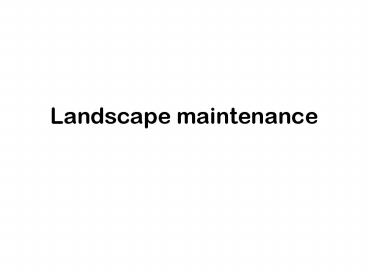Landscape maintenance - PowerPoint PPT Presentation
1 / 53
Title:
Landscape maintenance
Description:
Removal of undergrowth for appearance and fire prevention. Stimulate new, vigorous growth ... Crotch angles. Trees with central leaders. Standard form. Pruning ... – PowerPoint PPT presentation
Number of Views:1115
Avg rating:3.0/5.0
Title: Landscape maintenance
1
Landscape maintenance
2
Regular maintenance
- Soil maintenance
- pH and nutrient testing maintenance
- Amending
- Weed control
- Plant maintenance
- Irrigation
- Mulching
- Pest control (insects, disease, other organisms)
- Pruning
3
Landscape tools
4
Weed control
- Chemical control
- Pre-emergent vs. post-emergence
- Selective vs. nonselective
5
Weed control
- Hand weeding
- Landscape fabric
- Mulch
6
Irrigation
- Water supply to a plant
- Limited by root system
- Improve soil drainage, reduce soil compaction to
improve root growth - Avg. soil absorbs 3/8 water per hour
- Slow, less-frequent deep watering better than
frequent shallow watering - Soaker hose
- Drip irrigation
- Basin watering (berm)
7
Irrigation
8
Irrigation
- Hand watering
- Sprinkler irrigation
- Good for lawns, densely planted beds
- Wastes water (evaporation, unplanted areas)
- Can promote foliar diseases
- Fixed heads/risers
- Portable heads
- Drip/trickle irrigation
- Reduces water usage by gt50
- Can apply fertilizers
- Nozzles, pipes can clog
9
Irrigation
- Mulching/ground covers reduces frequent watering
needs - Standard 1/2 residential pipe can handle one
irrigation head (install ¾-1 piping if plan to
irrigate) - Generally need 1 water per week
- Lawns 1 per week
- Woody plants 3-4 total every 4 weeks
- Newly transplanted woody plants need to be
watered weekly (1st year), every 2 weeks (2nd
year)
10
Garden pests
11
Pest control
- Choose plants with minimal pest problems
- Insect pests are often vectors for disease
- Chemical control
- Contact poisons vs. systemic pesticides
- Synthetic vs. organic
12
Biological pest control
- Gardens Alive
- Home Harvest
13
Pruning
- Removal of excessive undesirable growth
14
Why prune?
- Sanitation
- Broken branches dead tissue
- Diseased parts
- Opening canopy
- Increase air flow reduce humidity
- Increase penetration of sprays
- Removal of undergrowth for appearance and fire
prevention - Stimulate new, vigorous growth
15
Why prune?
- Aesthetics
- Shape
- Formal hedges
- Topiary
16
Espalier
17
Vase-shaped trees
18
(No Transcript)
19
Pollarding
20
Why prune?
- Enhance reproduction
- Yield enhancement
- Fruiting shoots vs. non-fruiting shoots
- Increase flower size
- Fruit distribution, size, sugar content
uniformity - Access to fruit
21
Why prune?
- Manipulate physiology
- Pre-transplant root pruning
- Shoot tip pruning to promote branching
- Stimulate new growth on older plants Dwarfing
- Bonsai
22
Pruning tools
- Saws
- Shears
- Hand pruners
- Loppers
- Pole pruners
- Bypass vs. anvil
23
Pruning tools
- Sanitation
- Branch size and pruner damage
- Hand pruners (lt 1/2 inch dia.)
- Loppers (lt 2 inch dia.)
- Maintain sharp tools
- Clean cuts heal faster
24
Pruning principles
- Cutting is irreversible
- Breaking apical dominance changes form of plant
- Pruning invigorates regrowth
- Pruning can direct growth
- Timing of pruning is critical
- Spring flowers develop on previous seasons
growth - Summer and fall flowers develop on current
seasons growth
25
Pruning techniques
26
Prune inward growing branches
27
Pruning for outward growth
28
Prune rubbing branches
29
(No Transcript)
30
Included bark
31
Crotch angles
32
Trees with central leaders
- Standard form
33
(No Transcript)
34
Pruning Multiple leaders
35
Removing the central leader
36
Branched head standard
37
Multistemed tree form
38
Drop crotching controlling height
39
Pruning cuts
40
(No Transcript)
41
Pruning branches
- Cut at 900 angle
- Cut in stages
42
Pruning large branches
43
Pruning pines pinching candles
44
Pruning shrubs
- Heading back
45
Thinning
46
Renewal pruning (gradual renovation)
47
(No Transcript)
48
(No Transcript)
49
Coppice for color
50
(No Transcript)
51
Shearing
52
Hedge shapes
53
Training - Espalier































